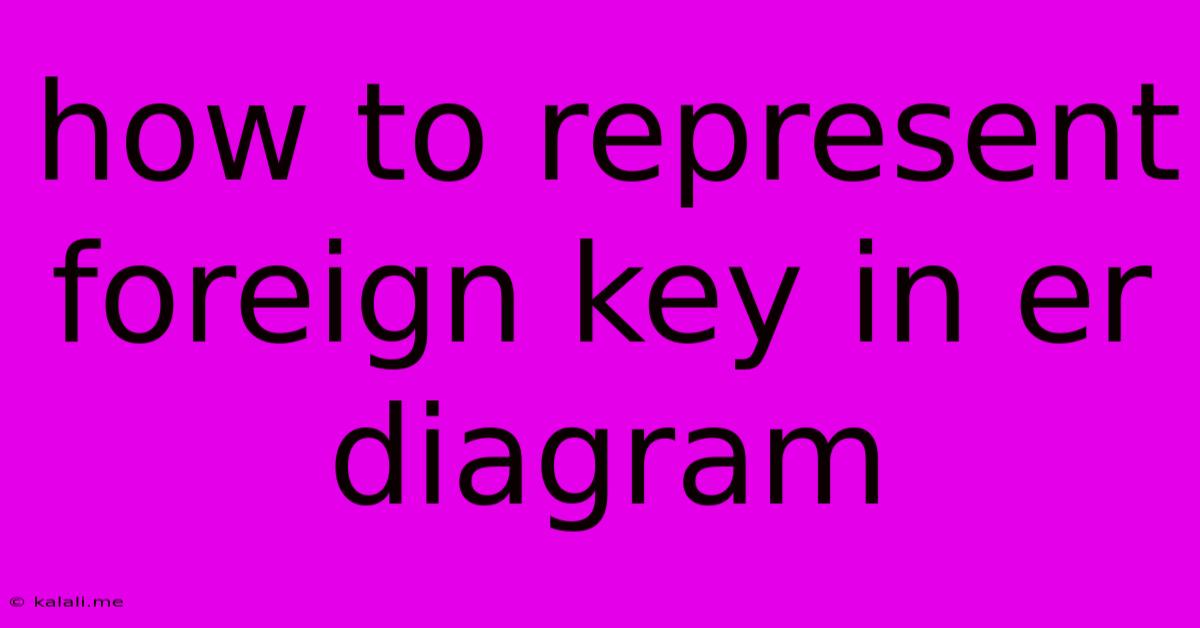How To Represent Foreign Key In Er Diagram
Kalali
May 29, 2025 · 4 min read

Table of Contents
How to Represent Foreign Keys in ER Diagrams
Entity-Relationship Diagrams (ERDs) are crucial for database design, providing a visual representation of entities, their attributes, and the relationships between them. A key component of many relationships is the foreign key, which establishes the link between tables. Understanding how to properly represent foreign keys in your ERD is essential for creating a well-structured and efficient database. This article will guide you through the process.
Understanding Foreign Keys and Their Purpose
Before diving into the visual representation, let's briefly recap what foreign keys are. A foreign key is a field (or collection of fields) in one table that refers to the primary key in another table. Its primary purpose is to establish and enforce a link between the two tables, ensuring referential integrity. This means that a foreign key value must either match a primary key value in the related table or be NULL (depending on the constraints set). Foreign keys prevent orphaned records – data in one table that doesn't have a corresponding entry in the related table. They are essential for maintaining data consistency and accuracy within a database.
Representing Foreign Keys in ER Diagrams: The Standard Notation
The most common way to represent a foreign key in an ER diagram is using a notation that clearly indicates the relationship and the involved keys. Here's how:
-
Relationships: Relationships between entities are depicted using lines connecting the relevant entity boxes. The type of relationship (one-to-one, one-to-many, many-to-many) is usually indicated using specific symbols or annotations on the connecting line.
-
Foreign Key Indication: The foreign key itself is not explicitly drawn within the entity box, but its presence is implicitly understood through the relationship line. You don't need to label every attribute within the entity as a foreign key within the ERD diagram, especially with larger models.
-
Crow's Foot Notation (Common Method): The most prevalent method is Crow's Foot notation. This notation uses symbols at the ends of the relationship lines to illustrate the cardinality (the number of instances involved in the relationship). For example:
-
One-to-many (1:N): A single instance in one entity can relate to multiple instances in another entity. This is usually represented with a "1" on one side of the line and a crow's foot (multiple lines converging) on the other.
-
One-to-one (1:1): A single instance in one entity relates to only one instance in another entity. This is shown with a "1" on both ends of the relationship line.
-
Many-to-many (M:N): Multiple instances in one entity can relate to multiple instances in another entity. This requires an intermediary entity (often called a junction table or associative entity) to handle the relationship, with each instance in the intermediary entity having a foreign key pointing to both of the entities.
-
Example Scenario
Let's consider a simple example: a database for an online store. We have two entities: Customers and Orders. A customer can place multiple orders, but an order belongs to only one customer.
Here's how this would be represented in an ER diagram:
-
Customers Entity: Contains attributes like
CustomerID(primary key),Name,Address, etc. -
Orders Entity: Contains attributes like
OrderID(primary key),OrderDate,TotalAmount, andCustomerID(foreign key referencingCustomers.CustomerID).
The ERD would show a line connecting the Customers and Orders entities. The line connecting Customers would end with a "1" and the line connecting Orders would end with a crow's foot (showing a 1:N relationship). The CustomerID attribute in the Orders entity would implicitly represent the foreign key.
Best Practices for Clarity
While the foreign key isn't explicitly labeled, clarity is still crucial. Consider these points:
-
Clear Relationship Labels: Label the relationships clearly to indicate the nature of the connection (e.g., "places," "belongs to").
-
Attribute Naming Conventions: Use consistent and descriptive naming for attributes, making it easy to identify primary and foreign keys.
-
Documentation: Supplement your ERD with documentation detailing the relationships and the specific foreign key constraints applied (e.g.,
ON DELETE CASCADE,ON UPDATE CASCADE).
By following these guidelines, you can create effective ER diagrams that clearly represent foreign keys and foster a robust database design. Remember, the key is clear communication of the database's structure and relationships.
Latest Posts
Latest Posts
-
The Blank Is Right Behind Me
May 30, 2025
-
How To Prevent Birds Flying Into Windows
May 30, 2025
-
How To Check Car Battery Life
May 30, 2025
-
How To Do A Tab On Iphone
May 30, 2025
-
Why Did My Fire Alarm Randomly Go Off Then Stop
May 30, 2025
Related Post
Thank you for visiting our website which covers about How To Represent Foreign Key In Er Diagram . We hope the information provided has been useful to you. Feel free to contact us if you have any questions or need further assistance. See you next time and don't miss to bookmark.